|
Cruising Modifications
for the Cape Dory 10 |
I had been boatless for neigh
on 6 years, having parted with a beloved ‘30’s vintage,
very wooden, 39’ Crocker Ketch at a point in my life when
throwing out the anchor seemed appropriate. Kids long grown
and the dog tired of five years of my live-aboard dream, and,
truth be told my bones were weary of basically three full time
occupations: main job, boat funding job, and boat repair job.
But six years was enough and when a friend offered me a free
Cape Dory 10 and an invitation to join the annual cruising raid…
CD 10 # 2038 was one of three dinghies owned by my pal Nim
Marsh and was the one which found its way to me during a consolidation
of his holdings in preparation for an upcoming marriage. Long
ignored before his acquisition, it had been band aided in order
to sail a couple times in the annual Great ‘Gansett Raid
conducted by the very much ad hoc and unofficial local chapter
of the Dinghy Cruising Association (UK) by resident members
of same here in Rhode Island, U.S. of A.
Sailed is this condition, by very experienced small boat sailors
the boat had acquired a reputation as a tender and unwieldy
vessel—in horse parlance, a high-spirited thoroughbred,
when sailed off the wind. This then was the boat, of dubious
distinction yet pedigreed heritage, which came to me as part
of the afore mentioned consolidation, in time to be renamed
SEA MINOR, repaired to a minor degree, repainted and
sent forth once again to do battle in yet another annual raid.
What follows is the story of SEA MINOR subsequent
to that experience or to be more precise the story of turning
the thoroughbred into a packhorse.
I am a fully grown man of 5’10” and 182 pounds
and have established preferences in how to handle small craft
in dirty weather garnered from many years of canoeing and rowing--having
commuted 1.5 miles each day for a period of five years, come
rain or come shine, in a 10’ Old Town dinghy to and from
my live aboard Crocker ketch. In sailing the Cape Dory 10 I
found the open space in the “cockpit” (the area
aft the centerboard trunk and forward the stern sheets comprising
the open floors) severely restricted due to large “winged”
sideboards.
|
CD 10 from the 1976 CD
brochure |
This was particularly an issue when single handed and running
in a stiffening breeze or with moderate seas—conditions
when it is desirable to carry your weight low in the boat near
the centerline yet have the ability to rapidly shift in order
to counteract puffs/sea conditions.
| Restrictive sternsheets, closed center thwart |
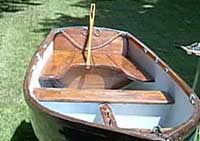
|
In rowing, I found the center thwart placement a bit low and
too far aft. Also, from the point of view of cruising, the midship
floatation chamber essentially divided the boat in two with
no ability to stow gear underneath or to extend one’s
legs for sleeping.
Given a full overhaul was required to address rotted wood,
failed polyester resin/ fiberglass bonds and other age induced
issues, attention would be paid the habitability concerns. Attention
also, subject of an earlier article The
Taming of the Shrew, re relocating the
mast step from the very bow aft to the forward thwart, would
be given the tenderness concerns.
In his catalogue, Lapstreak
Plywood Boat Designs, Ian Oughtred mentions
that he does not use sideboards in his boats of 10’. The
study plans of his Puffin (10’ 3”) show two options,
a straight board stern thwart or a minimum sheets arrangement
providing a nicely curved interface with the hull. This curved
design, retaining the existing floatation area, is the model
I chose to follow.
 |
Puffin (Oughtred) |
| SEA MINOR--modified sternsheet design |
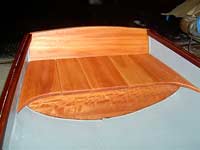
|
The center thwart situation was a tougher nut. It was heavily
bonded to the hull and made up nearly all of the hulls rigidity--moving
it posed major structural issues.
An adjusted thwart position taking into consideration my rowing
preferences was achieved using blocks and clamps to temporarily
position the old cover board in various positions as oars were
shipped and the boat dry rowed. Leg spacing, seat height, and
oarlock position were adjusted until a comfortable, custom fit
was found. This resolved the rowing position issues but despite
opening the area beneath the thwart, sleeping arrangements still
presented a problem—although I could work my way under
the seat and lay prone, turning over and, more of a concern,
getting up quickly, was impossible.
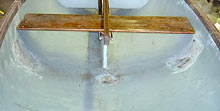 |
Test fitting center thwart |
In his book, Oar
& Sail, Kenneth Leighton mentioned a removable
center thwart. This idea appealed to me but I did not want to
be burdened with loose gear the size of the center thwart board
while trying to sleep and cook aboard. Further, I had weakened
the boat by removing the rigid center chamber and needed to
address this condition with the new design. Knees of some arrangement
were called for as well as the need to retain as much structural
rigidity as possible. To this end, I decided upon permanent
cleats, rather than stringers, tied to the hull with through-bolts
and knees—the seat board, hinged in the middle, would
screw to the port shelf and to a bearing pad fastened to the
centerboard trunk cover (see figures below).
| New thwart cleats and amidships bearing pad |
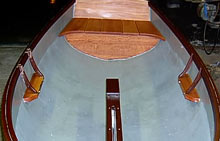
|
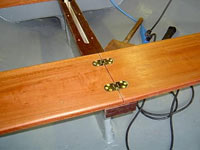 |
Thwart hinges |
The starboard end of the seat is fastened with a combination
of 3/8” nylon knockdown snap joints and a good size screw
toggle latch. The seat snaps onto the cleat by use of the nylon
knockdowns, allowing quick securing of the thwart in the event
rapid rowing from anchor is required. The screw latch makes
up the mechanical interface with the hull when sailing. Thus,
when day is done and anchor set, the starboard side of the thwart
maybe unlatched and swung over, out of the way, to lie atop
the port side of the seat.
| Nylon snap joints |
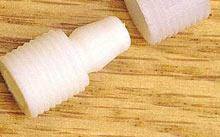
|
 |
Latch in place and tightened |
Floatation volume lost by removal of the center chamber is
made up with two 8X20” fenders. The choice of fenders
over floatation bags was one of multi-use. Space in a 10’
dinghy is limited and everything possible should serve more
than one task. The fenders, made fast along the keel outboard
the centerboard trunk , not only provide needed floatation to
maintain the original design requirement of 300# buoyancy but
during camping, may also be anchor pickup buoy and/or back rest
or, if docking, simply fenders.
| 7’ leathered spoon bladed oars, new
mast step, floatation |

|
Anchoring, Mooring
A close look at the original layout of the CD 10 will reveal
a lack ground tackle accommodations. Here, the original mast
step found service: there is a 2” diameter hole in the
breast hook and a drain hole centered in the bottom of the step.
The post was turned to provide a friction fit with the breast
hook and a 4” #14 bronze lag bolt bearing on rubber and
bronze washers was run up through the drain hole.
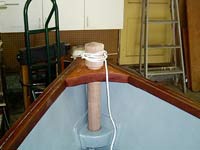 |
A Wicked Good Samson Post |
This arrangment proved valuable for towing as well as anchoring.
A four-pound “Bruce” style anchor with 15’
of light chain and 100’ of 3/8” nylon line formed
the rode.
The two belaying pins shown in the previous interior picture
(located in proximity to the mast step) provide places for hayard
and downhaul when sailing but also may be placed in the oarlock
sockets to function as cleats when tying to a dock.
| Rigged and ready--let’s go sailing! |
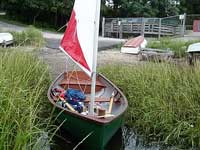
|

